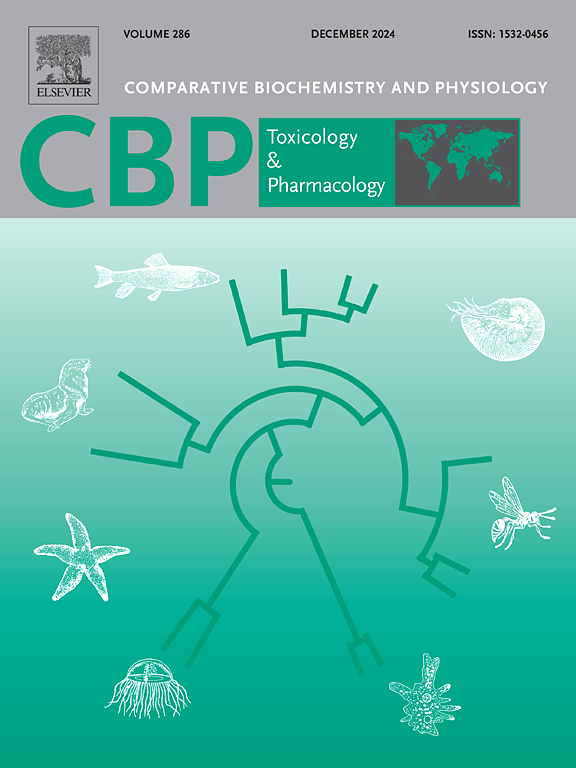Genome-wide identification and characterization of the carbonic anhydrase gene family reveals carbonate alkalinity adaptability in Chinese mitten crab (Eriocheir sinensis)
IF 4.3
3区 环境科学与生态学
Q2 BIOCHEMISTRY & MOLECULAR BIOLOGY
Comparative Biochemistry and Physiology C-toxicology & Pharmacology
Pub Date : 2025-06-17
DOI:10.1016/j.cbpc.2025.110255
引用次数: 0
Abstract
Carbonic anhydrase (CA) is an essential zinc metalloenzyme that plays a crucial role in the physiological process of acid-base regulation in aquatic species. The CA gene family has been characterized in multiple species, but a comprehensive analysis of the CA gene family in Eriocheir sinensis is yet to be conducted. In this study, we identified members of the CA gene family from the E. sinensis genome and analyzed their genomic physical distribution, structural characteristics, expression patterns, and cellular localization. The results revealed a total of 15 CA genes in E. sinensis, distributed across 12 chromosomes, with tandem duplication observed on chr43. Phylogenetic analysis indicated that the 39 CA genes from E. sinensis, Procambarus clarkii, and Portunus trituberculatus can be classified into 4 clades and 11 subclades, with events of gene duplication and loss observed. Transcriptome expression analysis suggested that the EsiCA7 gene might play a dominant role in the acid-base regulation of E. sinensis. Furthermore, subcellular localization experiments for the EsiCA1 and EsiCA7 genes confirmed the predictions made by bioinformatics analysis. In conclusion, this study provides a theoretical basis and molecular targets for further research on the function of the CA gene family and the mechanism of alkalinity tolerance in E. sinensis.

中华绒螯蟹碳酸酐酶基因家族的全基因组鉴定及其对碳酸盐碱度的适应性
碳酸酐酶(carbon anhydrase, CA)是一种重要的锌金属酶,在水生生物的酸碱调节生理过程中起着至关重要的作用。CA基因家族已在多个物种中得到表征,但尚未对中华绒螯蟹CA基因家族进行全面分析。在本研究中,我们从中华鄂蚊基因组中鉴定了CA基因家族成员,并分析了它们的基因组物理分布、结构特征、表达模式和细胞定位。结果表明,中华绒螯蟹共有15个CA基因,分布在12条染色体上,在chr43上存在串联重复。系统发育分析表明,中华鄂蚊、克氏原螯虾和三管梭鲈的39个CA基因可分为4个支系和11个亚支系,并存在基因复制和丢失事件。转录组表达分析表明,EsiCA7基因可能在中华鄂螨的酸碱调控中起主导作用。此外,EsiCA1和EsiCA7基因的亚细胞定位实验证实了生物信息学分析的预测。综上所述,本研究为进一步研究中华鄂蚌CA基因家族的功能及耐碱性机制提供了理论基础和分子靶点。
本文章由计算机程序翻译,如有差异,请以英文原文为准。
求助全文
约1分钟内获得全文
求助全文
来源期刊
CiteScore
7.50
自引率
5.10%
发文量
206
审稿时长
30 days
期刊介绍:
Part C: Toxicology and Pharmacology. This journal is concerned with chemical and drug action at different levels of organization, biotransformation of xenobiotics, mechanisms of toxicity, including reactive oxygen species and carcinogenesis, endocrine disruptors, natural products chemistry, and signal transduction with a molecular approach to these fields.

 求助内容:
求助内容: 应助结果提醒方式:
应助结果提醒方式:


